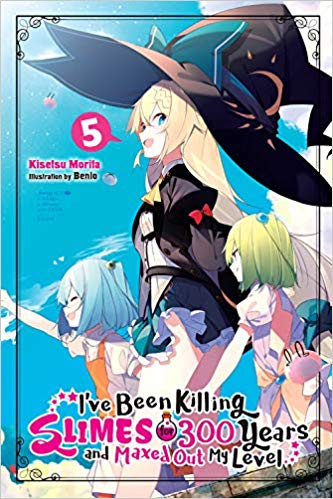By Kisetsu Morita and Benio. Released in Japan as “Slime Taoshite 300 Nen, Shiranai Uchi ni Level MAX ni Nattemashita” by GA Novels. Released in North America by Yen On. Translated by Jasmine Bernhardt.
I’ve gradually gotten used to this being the isekai version of K-On! (the illustrations helping along, as they get more and more ‘moe’ with every volume), and this volume in particular reminds me that Azusa’s laid-back style works so well here because the entire world is laid-back. The idea of someone being killed off or an evil villain trying to take over the world feels so foreign to everything we’ve read here to date, and the result is that you have a reader who is completely relaxed in reading this book. There’s never any serious conflict, and that’s good! The characters are all various varieties of “cute girls doing cute things’, and that’s good too! There are no stories in this series that run longer than about a quarter of the book, so you don’t have to pay too much attention, and if a character returns, you’re helpfully reminded where they showed up before. On the downside, reading this may make you fall asleep.
Things that happen in this book: At Pecora’s birthday party, she changes Azusa into a fox girl, which ends up backfiring when Azusa starts beating up everyone in the demon kingdom in an effort to eat abura-age, which reminds you how Japanese this series is and also likely makes you turn to Google. Azusa and company then go to see one of the goddesses in this world speaking at what amounts to a business convention, and she is startled to find this is the goddess who first sent her to this world… who has since been demoted, as she refused to deal with anything but cute girls. There’s a battle to see who the next Dragon Lord is, which turns out to be a typical beauty contest. We get Around the World in 80 Days, Killing Slimes style, which is to say it’s pretty boring. And in the longest story in the book, the cast discover an ancient civilization, now inhabited by stuffy ghosts and a very unstuffy ruler who is annoyed no tsukkomis exist here.
This is fun and insubstantial as always. The ancient ghost queen is amusing as she talks in a broad accent, and also seems content to treat her temple like it’s a dungeon raid. Azusa is less grumpy than usual here, having fully accepted everyone’s eccentricities. That may, in fact, be the biggest negative in the book – everyone’s gotten too used to each other. No one fights anymore, no one gets upset. Conflicts are resolved almost immediately. It’s definitely a series that you should read after you’ve read a volume of something serious, bulky and filled with plot – it acts as a dessert or a palette cleanser. That said, this is absolutely the worst kind of series to marathon. If you read all seven books at once, you’ll give up. One book every few months is just the right pace.



